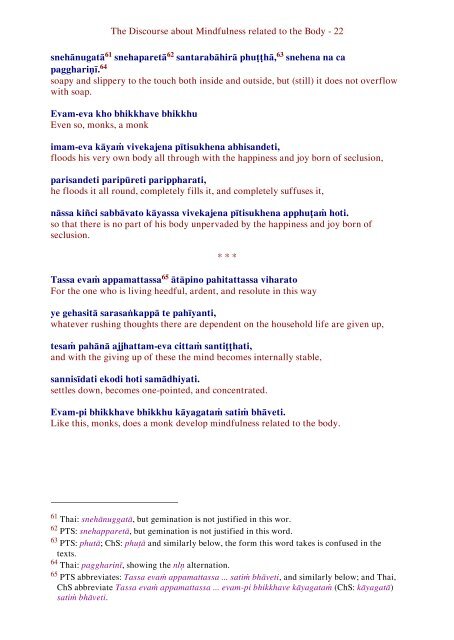Kayagatasatisuttam, the Discourse about Mindfulness related to the Body
A Pāli and English line by line (interlinear) version of this important discourse about the development of various meditations related to the body (together with extensive annotation).
A Pāli and English line by line (interlinear) version of this important discourse about the development of various meditations related to the body (together with extensive annotation).
You also want an ePaper? Increase the reach of your titles
YUMPU automatically turns print PDFs into web optimized ePapers that Google loves.
The <strong>Discourse</strong> <strong>about</strong> <strong>Mindfulness</strong> <strong>related</strong> <strong>to</strong> <strong>the</strong> <strong>Body</strong> - 22<br />
snehānugatā 61 snehaparetā 62 santarabāhirā phuṭṭhā, 63 snehena na ca<br />
pagghariṇī. 64<br />
soapy and slippery <strong>to</strong> <strong>the</strong> <strong>to</strong>uch both inside and outside, but (still) it does not overflow<br />
with soap.<br />
Evam-eva kho bhikkhave bhikkhu<br />
Even so, monks, a monk<br />
imam-eva kāyaṁ vivekajena pītisukhena abhisandeti,<br />
floods his very own body all through with <strong>the</strong> happiness and joy born of seclusion,<br />
parisandeti paripūreti parippharati,<br />
he floods it all round, completely fills it, and completely suffuses it,<br />
nāssa kiñci sabbāva<strong>to</strong> kāyassa vivekajena pītisukhena apphuṭaṁ hoti.<br />
so that <strong>the</strong>re is no part of his body unpervaded by <strong>the</strong> happiness and joy born of<br />
seclusion.<br />
* * *<br />
Tassa evaṁ appamattassa 65 ātāpino pahitattassa vihara<strong>to</strong><br />
For <strong>the</strong> one who is living heedful, ardent, and resolute in this way<br />
ye gehasitā sarasaṅkappā te pahīyanti,<br />
whatever rushing thoughts <strong>the</strong>re are dependent on <strong>the</strong> household life are given up,<br />
tesaṁ pahānā ajjhattam-eva cittaṁ santiṭṭhati,<br />
and with <strong>the</strong> giving up of <strong>the</strong>se <strong>the</strong> mind becomes internally stable,<br />
sannisīdati ekodi hoti samādhiyati.<br />
settles down, becomes one-pointed, and concentrated.<br />
Evam-pi bhikkhave bhikkhu kāyagataṁ satiṁ bhāveti.<br />
Like this, monks, does a monk develop mindfulness <strong>related</strong> <strong>to</strong> <strong>the</strong> body.<br />
61 Thai: snehānuggatā, but gemination is not justified in this wor.<br />
62 PTS: snehapparetā, but gemination is not justified in this word.<br />
63 PTS: phutā; ChS: phuṭā and similarly below, <strong>the</strong> form this word takes is confused in <strong>the</strong><br />
texts.<br />
64 Thai: paggharinī, showing <strong>the</strong> n/ṇ alternation.<br />
65 PTS abbreviates: Tassa evaṁ appamattassa ... satiṁ bhāveti, and similarly below; and Thai,<br />
ChS abbreviate Tassa evaṁ appamattassa ... evam-pi bhikkhave kāyagataṁ (ChS: kāyagatā)<br />
satiṁ bhāveti.

















